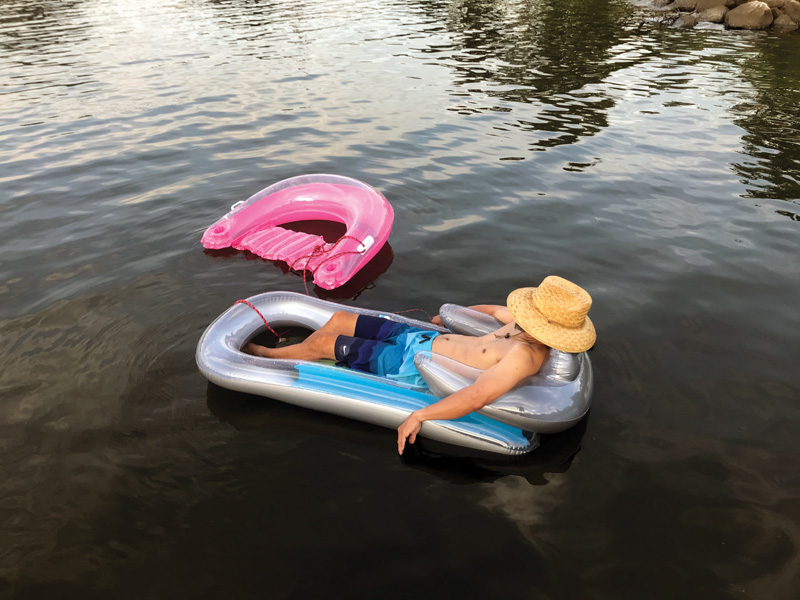Sailors and climate change
At the peak of summer, initial impacts of climate change sometimes become evident, especially to us sailors who spend a lot of time outside and on the water. According to the Fourth National Climate Assessment published in 2018, heat waves, extreme weather, and coastal flooding will all become more common in coming years and decades (see the article “Climate Change and Its Impact on Storms”). While some sailors may have already noticed hotter days or less predictable storms, other impacts might be less obvious. One of these is how climate change will affect vibrio in the Chesapeake Bay.

What is vibrio?
Vibrio is a genus of bacteria that includes over 100 different species that can survive and reproduce in water. Some species can cause infections in humans. Cholera is one of the most well-known species of vibrio but prefers to dwell in freshwater environments. In the brackish Chesapeake Bay, two other species raise the highest levels of concern: V. parahaemolyticus and V. vulnificus.
Both V. parahaemolyticus and V. vulnificus can be contracted by eating raw oysters and other shellfish that are infected with it, or by swimming in infected waters with an open wound. V. parahaemolyticus is by far the most common type of vibrio infection, with an estimated 34,000 annual cases in the U.S. Its symptoms are those of food poisoning or a skin infection, depending on whether it was contracted from eating shellfish or swimming, and are usually self-resolving. Occasionally, severe cases require intervention with antibiotics. V. vulnificus, while much rarer and only having a few hundred cases reported annually in the U.S., is much more severe.
Vibrio and the Chesapeake Bay
Both species of vibrio thrive in warm, moderate salinity (brackish) waters like the Chesapeake Bay. Their abundance in the Bay is seasonal, peaking in the summer when the water temperature is warmest. The ideal water temperature for vibrio bacteria to survive and reproduce is 98-102 degrees Fahrenheit, and their abundance increases linearly with water temperature at any point over 59 degrees.
According to a 2021 article in the Journal of the American Water Resources Association, temperature records show that the waters of the Chesapeake Bay have experienced more rapid rates of warming during the past 100 years than at any other point in the previous two millennia. This means that, while the Bay is not immediately at risk of becoming the ideal temperature for vibrio, climate change’s continued impact on its water temperature will make it more hospitable for the bacteria. In a warmer world, vibrio presence in the Chesapeake will be more likely and higher concentrations of vibrio bacteria will be more common. A 2017 study published in GeoHealth, an academic journal, estimated that vibrio concentrations in Chesapeake Bay oysters would increase by 1.5 times under the most conservative climate change model, and up to three times in the most extreme model.
If the amount of vibrio bacteria in regional waters increases as predicted, this could pose a serious risk to boaters and anyone else who enjoys the Bay. It could become much riskier to eat oysters and other shellfish, or to go for a dip to cool down after a long sail in the August heat.
What Can We Do?
There are several ways that states, towns, and individuals in the Bay region can protect themselves from vibrio. One of the best ways would be to set up an environmental monitoring system, as other at-risk regions have already done. NOAA buoys around the Bay already gather all of the data necessary to calculate the risk of vibrio presence in the water on any given day, since that risk is largely determined by environmental factors like water temperature and salinity. That data could be organized into a program where the risk of vibrio is calculated and made publicly available so that individuals could make informed decisions about whether or not they should go into the water or eat fresh shellfish on any given day, week, or month.
Individuals can also protect themselves. If you enjoy raw oysters and other shellfish, make sure you know where they came from. There are regulations already in place designed to reduce the risk of vibrio exposure from raw oysters and making sure you’re getting yours from a reputable source helps ensure that those regulations are being followed. The key is to make sure they’re getting refrigerated as soon as possible and not left out on a hot dock or table for too long before being eaten.
Don’t go for a swim if you have any open cuts or scrapes, especially if you have any preexisting conditions that weaken your immune system. And if you have any open wounds that get exposed to the water, treat them with antiseptic first aid products and pay close attention to them for signs of infection. An infection caught early and treated properly can turn out to be little more than an inconvenience.
The potential for more vibrio in the Bay isn’t a reason to stop enjoying it altogether, but it is a good reason to pay attention, make smart choices about when to get in the water, and as always, continue working to reduce your impact so that we can all help reduce climate change and its effects.
By Kelsey Bonham
About the author: Chesapeake sailor Kelsey Bonham recently graduated from Colgate University with a degree in enviornmental geography, studying climate change, sustainability, and the complex relationships between people and our enviornment.
For more information about vibrio, check out the CDC’s fact sheet.
For more information about vibrio, climate change, and the Chesapeake Bay, check out my full report here.




